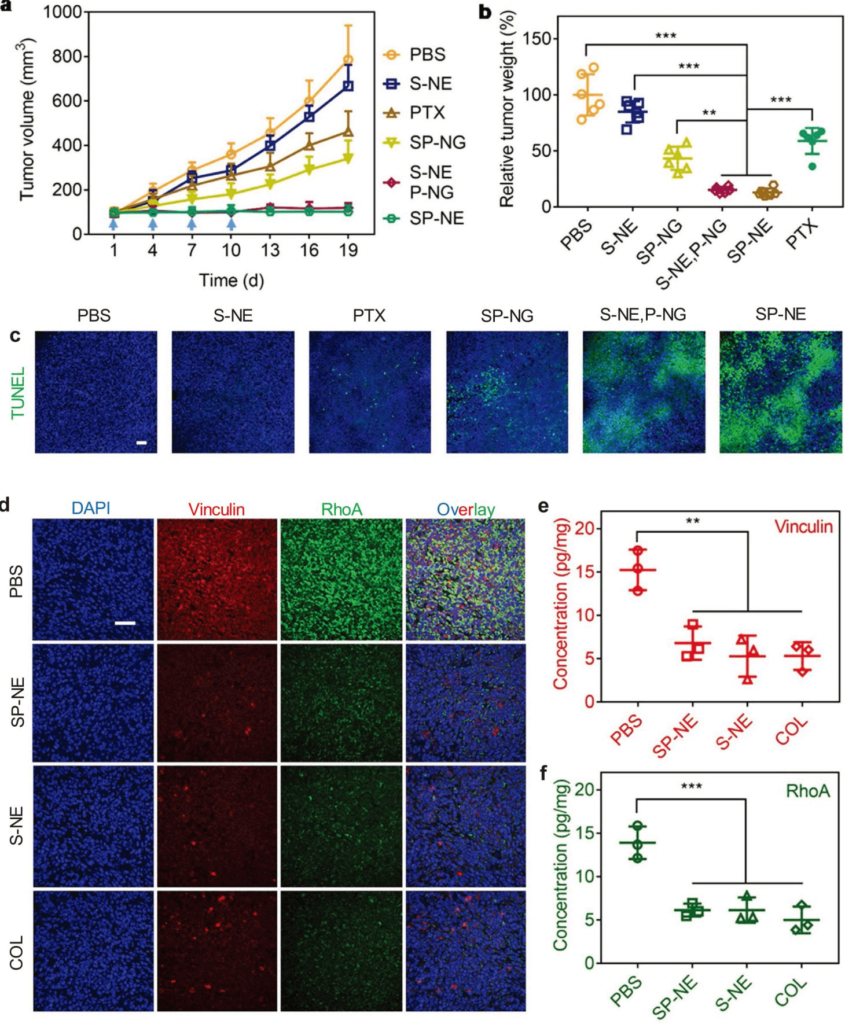FineTest Elisa kit contributes to the research on tumor microenvironment and nanomedicine. The immunoassay is designed to measure RhoA concentration in tumor tissue homogenates.
Publication Details
Article Title: Tumor Microenvironment-Activatable Nanoenzymes for Mechanical Remodeling of Extracellular Matrix and Enhanced Tumor Chemotherapy
Journal Title: Advanced Functional Materials
DOI: 10.1002/adfm.202007544
IF: 18.808
PMID: 33484643
Abstract: Increased tissue stiffness is a hallmark of cancer and promotes tumor progression. It is hypothesized that decreased tumorous stress may aid or sensitize chemotherapies. To overcome extracellular matrix (ECM) stiffening and fulfill sensitized chemotherapy in one nanosystem, a reactive oxygen species-activatable nanoenzyme (SP-NE) based on a dendritic polyglycerol scaffold, integrating collagenase and paclitaxel (PTX) prodrug, is constructed. The dense and tough ECM is highly remitted by SP-NE in the tumor microenvironment (TME) mimicking gelatin hydrogel models, which causes cell shrinkage, disorders cytoskeletal constructions, and subsequently enhances chemotherapeutic efficacy. ECM softening via SP-NE downregulates mechanotransduction signaling pathways of integrin-focal adhesion kinase (FAK)-Ras homolog family member A (RhoA) implicated in cytoskeletal assembly, and integrin-FAK-phosphorylated extracellular signal regulated kinase (pERK 1/2) mediating mitosis. Notably, this programmed nanosystem in human breast MCF-7 tumor-bearing mice models displays a significant relief of ECM stress from 4300 to 1200 Pa and results in 87.1% suppression of tumor growth at a low PTX dosage of 3 mg kg−1. The attenuated expression of the key players RhoA and pERK 1/2 involved in cellular mechano-sensing is further verified in vivo. This study thus provides a new and potential nanoplatform to selectively decrease TME stiffness for enhanced chemotherapy.
Keywords: Mechanical Remodeling, Nanomedicine, Sensitized Chemotherapy, Tumor Microenvironment, Tumor Stiffness
Immunoassay
| FineTest Product | Sample | Detection Target | Species |
| Human RHOA(Transforming protein RhoA) ELISA Kit (EH2484) | tumor tissue homogenate | RHOA | Human |
As illustrated in Fig. 5f, ELISA analysis revealed shrinkages of about 55.4% for vinculin expression, 55.8% for RhoA expression, and 63.5% for pERK 1/2 expression in SP-NE-treated group relative to the PBS group.
Validated Image

Figure Source: Advanced Functional Materials, 2020 Oct;31(3). doi: 10.1002/adfm.202007544.
Figure 5. In vivo therapeutic efficacy of SP-NE in MCF-7 tumor-bearing mice models: CLSM immunofluorescence images of MCF-7 tumors from different groups at the end of the experiments. Blue signals, nucleus; red signals, vinculin; green signals, RhoA. Scale bar: 100 μm. e,f) ELISA analysis of vinculin (e) and RhoA (f) levels in MCF-7 tumors treated by different groups at the end of the experiments (n = 3). **p < 0.01; ***p < 0.001, one-way ANOVA, Tukey’s post-hoc analysis.
